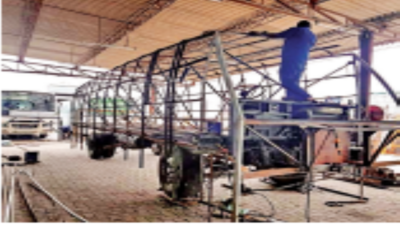Top Searches
- News
- City News
- chennai News
- Karur needs a reset
Karur needs a reset

Karur supplies dining room, kitchen and living room fabrics to global brands.
For centuries, Karur was a popular trading hub known for its handlooms and weaving. Over the last 40-50 years, this district in the Cauvery delta made a mark in home textiles, bus body building and mosquito net fabrics. And, many of Karur’s entrepreneurs are among those who fund the great Indian election circus.
Karur supplies dining room, kitchen and living room fabrics to global brands. It’s a ₹9,000 crore industry, with more than ₹5,000 crore in exports, most of it to the US and Europe. With around 800 manufacturing and 1,000 supporting units, the sector offers jobs to two lakh unskilled and semi-skilled people, mostly women.
With 60-75 units – all MSMEs – the bus building industry in the district had an annual turnover of ₹500 crore to ₹750 crore in pre-Covid days, and employed 25,000 people.
Started in 1975, Karur’s mosquito net fabric industry employed more than 50,000 people by the early 1990s catering to the Indian market. It is now a ₹2,200 crore industry -with ₹1,200 crore coming from exports – and employs about one lakh people.
But Karur is now at a crossroads, with all these three sectors facing challenges. The home textiles segment is threatened by global preferences shifting away from natural fibre (cotton) towards sustainability. Post-Covid changes and policy shifts have hit the bus body segment. And, the global recession is squeezing the mosquito net business.
“We have a vision to make the Karur textile cluster a 25,000 crore industry, including 15,000 crore in exports, by 2030.
To achieve that we are working closely with the state government. We need a trade facilitation centre with a multi-purpose convention hall, permanent expo centre, besides a museum to showcase history of the Karur cluster and a skill development centre,” says P Gopalakrishnan, president, Karur Textile Manufacturer Exporters Association.
Every year, 4-5 exhibitions relating to the textile industry are held in wedding halls. “A permanent centre can help conduct such exhibitions, including those for finished goods, at Karur itself by inviting big brands from India and abroad, instead of going to Mumbai and New Delhi,” he says. “We have formed a young generation group and are offering lot of ideas to change the line of focus from traditional textiles to technical textiles, especially since the world is moving towards man-made fibre,” he adds.
“Covid dealt a bodyblow to the bus body industry. Though there are signs of revival from staff and mofussil bus segments, the situation looks grim with dip in city and mini-bus business segment,” says T Muruganandam of PEETEE Coach Builders and president, Association of Automobile Coach Builders Karur.
The global recession has hit mosquito net fabric manufacturers, especially since two ofthe 12 global suppliers for WHO are from this district. “The space has now got crowded. The small operators are facing issues over high-cost power charges and labour issues, since the industry is now depending mostly on migrant workers. We have sought subsidized power from the government, besides quarters for accommodating migrant workers,” says A R Malaiyappasamy, president, Karur HDPE Filament and Bednets Manufacturers Welfare Association.
Karur has another problem: The cost of land is quite high, while availability is limited. As a result, prospects of large industries setting up base in the district are dim. The district has to focus on MSMEs.
“We find exciting new opportunities emerging for Karur-based entrepreneurs through the Centre’s ‘Make in India’ initiative of developing indigenous vendors, especially for railways and defence,” says C Basker, managing partner, VNC Group. “Karur can be a hub for units that service large industries given its strategic location, financial resources, qualified manpower and honest entrepreneurs who compete to repay loans,” he adds.
Senthil Sankar, vice-chairman, CII – Karur Zone, and managing partner, Shree Renga Polymers, agrees. “Karur needs to evolve and focus on new industries and money has to come from outside. I don’t think the Karurians will invest in any industry that is futuristic, until the NextGen with global experience and exposure comes up,” he says.
Karur supplies dining room, kitchen and living room fabrics to global brands. It’s a ₹9,000 crore industry, with more than ₹5,000 crore in exports, most of it to the US and Europe. With around 800 manufacturing and 1,000 supporting units, the sector offers jobs to two lakh unskilled and semi-skilled people, mostly women.
With 60-75 units – all MSMEs – the bus building industry in the district had an annual turnover of ₹500 crore to ₹750 crore in pre-Covid days, and employed 25,000 people.
Started in 1975, Karur’s mosquito net fabric industry employed more than 50,000 people by the early 1990s catering to the Indian market. It is now a ₹2,200 crore industry -with ₹1,200 crore coming from exports – and employs about one lakh people.
But Karur is now at a crossroads, with all these three sectors facing challenges. The home textiles segment is threatened by global preferences shifting away from natural fibre (cotton) towards sustainability. Post-Covid changes and policy shifts have hit the bus body segment. And, the global recession is squeezing the mosquito net business.
“We have a vision to make the Karur textile cluster a 25,000 crore industry, including 15,000 crore in exports, by 2030.
To achieve that we are working closely with the state government. We need a trade facilitation centre with a multi-purpose convention hall, permanent expo centre, besides a museum to showcase history of the Karur cluster and a skill development centre,” says P Gopalakrishnan, president, Karur Textile Manufacturer Exporters Association.
Every year, 4-5 exhibitions relating to the textile industry are held in wedding halls. “A permanent centre can help conduct such exhibitions, including those for finished goods, at Karur itself by inviting big brands from India and abroad, instead of going to Mumbai and New Delhi,” he says. “We have formed a young generation group and are offering lot of ideas to change the line of focus from traditional textiles to technical textiles, especially since the world is moving towards man-made fibre,” he adds.
“Covid dealt a bodyblow to the bus body industry. Though there are signs of revival from staff and mofussil bus segments, the situation looks grim with dip in city and mini-bus business segment,” says T Muruganandam of PEETEE Coach Builders and president, Association of Automobile Coach Builders Karur.
The global recession has hit mosquito net fabric manufacturers, especially since two ofthe 12 global suppliers for WHO are from this district. “The space has now got crowded. The small operators are facing issues over high-cost power charges and labour issues, since the industry is now depending mostly on migrant workers. We have sought subsidized power from the government, besides quarters for accommodating migrant workers,” says A R Malaiyappasamy, president, Karur HDPE Filament and Bednets Manufacturers Welfare Association.
Karur has another problem: The cost of land is quite high, while availability is limited. As a result, prospects of large industries setting up base in the district are dim. The district has to focus on MSMEs.
“We find exciting new opportunities emerging for Karur-based entrepreneurs through the Centre’s ‘Make in India’ initiative of developing indigenous vendors, especially for railways and defence,” says C Basker, managing partner, VNC Group. “Karur can be a hub for units that service large industries given its strategic location, financial resources, qualified manpower and honest entrepreneurs who compete to repay loans,” he adds.
Senthil Sankar, vice-chairman, CII – Karur Zone, and managing partner, Shree Renga Polymers, agrees. “Karur needs to evolve and focus on new industries and money has to come from outside. I don’t think the Karurians will invest in any industry that is futuristic, until the NextGen with global experience and exposure comes up,” he says.
Start a Conversation
FOLLOW US ON SOCIAL MEDIA
FacebookTwitterInstagramKOO APPYOUTUBE









